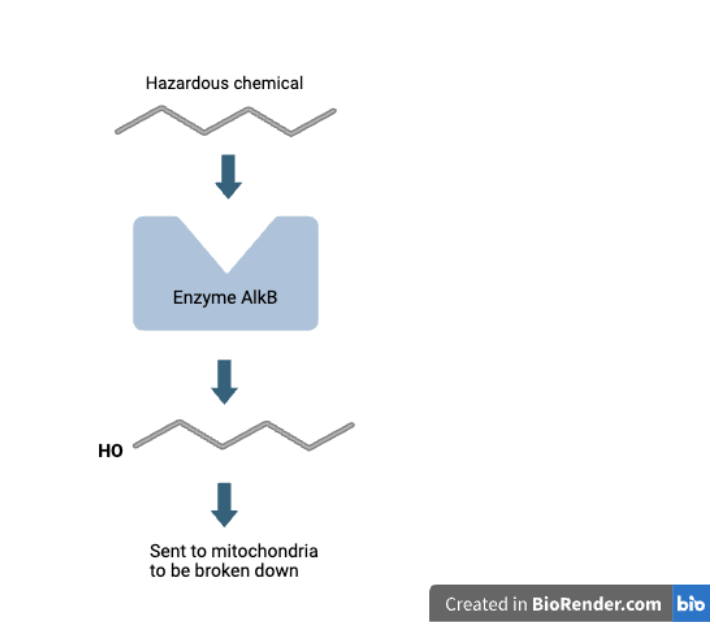In 2010, about 4.1 million barrels of oil were released into the Gulf of Mexico. This was a terrible disaster that, even after 14 years, hasn’t been entirely fixed. However, it’s thanks to a technique called bioremediation that this oil spill has made progress towards recovery. Bioremediation is a process that uses microorganisms to degrade harmful pollutants like petroleum. These cells are able to live in seemingly inhospitable environments and use toxic material as a food source. This conveniently removes the waste and avoids having to dispose of it in another location such as a landfill. In 2017, this oil spill was recreated in a lab, allowing scientists to find a group of bacteria that could consume substances like petroleum. Now that we know about the specific species of bacteria that can metabolize the oil, we can use it for environmental restoration projects for years to come.
Petroleum is made up of long chains of carbon and hydrogen atoms. These hydrocarbons store an incredible amount of potential energy which is what makes petroleum such an effective source of fuel. Most organisms don’t have the enzymes needed to break down these hydrocarbons and tap into their metabolic energy. However, certain microbes have an enzyme called alkane monooxygenase, or AlkB for short. AlkB is able to turn molecules like petroleum into alcohols by adding oxygen and hydrogen. In the process, this breaks the end of the carbon and hydrogen chain. The new molecules can then be shuttled to the cells’ mitochondria where they can be further broken down and used for cellular respiration. At the site of the Gulf of Mexico oil spill, scientists found an abundance of AlkB within the microbial community that had developed there. A silver lining to this terrible oil spill is that it revealed the precise biochemical processes involved in bioremediation so that we can take advantage of the AlkB enzyme for future environmental restoration.

Researchers can also use bioremediation to restore polluted drinking water. Polluted water often contains heavy metals that can be very harmful if they end up in a water supply. This can be purified using microorganisms that transform these dangerous metals through oxidation-reduction reactions. Toxic metals can also be removed using plants. Polluted freshwater might not seem like a good place for a plant to thrive, but certain plants are actually very tolerant of high concentrations of metals. In Los Angeles, researchers are using plants such as the California Buckwheat to remove lead and other dangerous metals. These plants are able to absorb the metal, which accumulates inside the plant. Later, the plants can be harvested, effectively removing the metal inside them.
Nature-based solutions might be the best way to address pollution and habitat destruction. It’s possible that every harmful chemical that seeps into the environment has an obscure organism that can easily absorb or metabolize it. We’ve only just become aware of this, and there are certainly more organisms we can learn from.
References
Bala, S., Garg, D., Thirumalesh, B. V., Sharma, M., Sridhar, K., Inbaraj, B. S., & Tripathi, M. (2022). Recent Strategies for Bioremediation of Emerging Pollutants: A Review for a Green and Sustainable Environment. Toxics, 10(8), 484. https://doi.org/10.3390/toxics10080484
Coelho, L. M., Rezende, H. C., Coelho, L. M., de Sousa, P. A. R., Melo, D. F. O., & Coelho, N. M. M. (2015). Bioremediation of Polluted Waters Using Microorganisms. InTech. doi: 10.5772/60770
Fonsegrives, R. (2023). Fungi and plants clean up California Pollution. Phys.org. https://phys.org/news/2023-05-fungi-california-pollution.html
Guo, X., Zhang, J., Han, L. et al. (2023). Structure and mechanism of the alkane-oxidizing enzyme AlkB. Nat Commun 14, 2180 https://doi.org/10.1038/s41467-023-37869-z
Hu, P., Dubinsky, E. A., Probst, A. J., Wang, J., Sieber, C. M. K., Tom, L. M., Gardinali, P. R., Banfield, J. F., Atlas, R. M., & Andersen, G. L. (2017). Simulation of Deepwater Horizon oil plume reveals substrate specialization within a complex community of hydrocarbon degraders. https://doi.org/10.1073/pnas.1703424114
Wang, L.; Rinklebe, J.; Tack, F.M.G.; Hou, D. A review of green remediation strategies for heavy metal contaminated soil. Soil Use Manag. (2021), 37, 936–963. https://doi.org/10.1111/sum.12717
